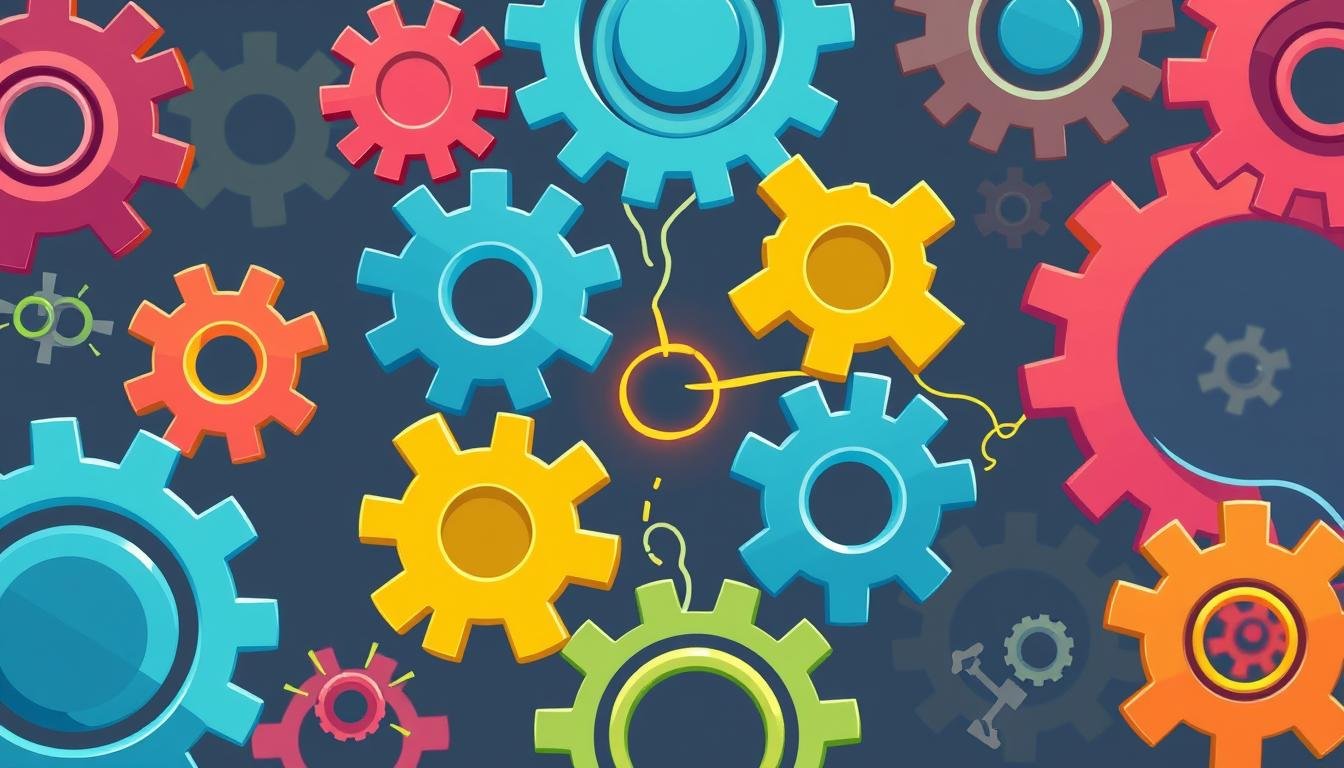Mastering Team Dynamics: The Psychological Keys to High-Performing Teams
Ever wondered why some teams excel while others struggle? The answer lies in team dynamics. This complex force influences how groups interact and perform. Let’s explore what makes top teams tick.
Imagine a workplace where ideas flow freely and everyone trusts each other. This is real for companies that get team dynamics right. Companies like Pixar and Google know that teamwork is key, not just talent.
A study of 1,004 employees showed that high-performance teams are happier. They’re also five times more productive than average teams. This highlights the importance of team dynamics for success.
So, what makes a team work well? Kurt Lewin’s 1939 study found that team dynamics are about positive and negative forces. These forces shape the team’s environment, affecting its success.
Good team dynamics build trust and encourage teamwork. They lead to better ideas and innovations. Bad dynamics, however, can stop projects and stifle creativity.
As we learn about team dynamics, we’ll discover how to boost performance. We’ll cover trust, diversity, and more. You’ll get the tools to make your team more productive and innovative.
Key Takeaways
- High-performing teams are 3x more likely to achieve above-average results
- Positive team dynamics lead to increased trust and productivity
- Effective communication is crucial for strong team performance
- Embracing diversity enhances problem-solving capabilities
- Continuous learning and improvement drive team growth
Understanding the Foundations of Team Dynamics
Team dynamics are key to success at work. They influence how team members work together and reach goals. Good team dynamics boost productivity and creativity. Bad ones can cause conflict and lower motivation.
Defining Team Dynamics in the Workplace
Team dynamics are about how people in a group interact. They include how they communicate, make decisions, and solve problems together. Building a strong team focuses on creating positive interactions to improve teamwork and performance.
Team Dynamics vs. Group Dynamics
Team dynamics and group dynamics are not the same. Teams have clear goals and work together closely. Groups might not have a specific purpose. Teams need careful management to work towards common goals.
Importance for Organizational Success
Strong team dynamics are crucial for success. They lead to more productivity, better decisions, and happier employees. Teams with good dynamics are 50% more effective. Clear communication and trust help teams work better together.
| Benefit | Impact |
|---|---|
| Lower Absenteeism | 41% reduction |
| Higher Productivity | 17% increase |
| Increased Profitability | 21% growth |
By focusing on team building and positive interactions, organizations can create a supportive environment. This environment encourages innovation, keeps employees, and drives success.
The Role of Trust in Building High-Performing Teams
Trust is key for high-performing teams. It holds them together, creating a strong bond. A study of 1,000 U.S. office workers showed how trust works in teams.
High-performing teams trust in four main ways:
- Trusting each other to deliver
- Trusting to share new ideas
- Trusting to disagree constructively
- Trusting to make and learn from mistakes
Interestingly, 66% of remote teams are high-performing, compared to 47% of on-site teams. This shows trust can work without being in the same place. It’s about good communication and clear roles.
Leaders are vital in building trust. They create a safe space for sharing ideas and disagreements. Regular team meetings help everyone stay on the same page, building trust.
“Trust is a two-way street that requires brands, leaders, and managers to earn it.”
Teams that perform well see disagreements as chances to grow. They face issues head-on, keeping trust strong. This makes the team better and more innovative.
By focusing on trust, teams can do better, no matter where they work. Trust is not just good; it’s crucial for success in today’s varied work settings.
Cultivating Psychological Safety for Enhanced Team Performance
Psychological safety is key for team building and working together. Google’s Project Aristotle showed its importance for top teams. Let’s see how it affects team work and success.
Google’s Project Aristotle Findings
Project Aristotle, Google’s big study, found psychological safety is crucial. It showed teams with safety were more creative and innovative.
Fostering Psychological Safety
To make a safe team space, leaders can do a few things:
- Encourage open communication
- Promote diverse perspectives
- Provide constructive feedback
- View mistakes as learning opportunities
- Recognize and celebrate contributions
Companies like Google and Microsoft have made these strategies work. They focus on safety to boost team performance.
Impact on Innovation and Creativity
Psychological safety helps teams be more innovative. It lets them take risks and share new ideas. This way, they’re not afraid to try new things.
“Psychological safety is not about being nice. It’s about giving candid feedback, openly admitting mistakes, and learning from each other.”
With safety, teams solve problems better and make decisions faster. They also handle conflicts well. This leads to learning and growth, making teams more innovative and creative.
Effective Communication: The Cornerstone of Strong Team Dynamics
Effective communication is key to strong team dynamics. It’s what keeps the team together and shapes how they work together. In fact, 67% of employees say clear and open communication is vital for team engagement.
When communication is open, team roles become clear. Everyone knows their part and how they help the team. This leads to better teamwork and results.
Poor communication can hold a team back. 46% of employees say bad communication causes delays. To fix this, many teams use technology. 82% of managers like using project management software to improve communication.
Regular meetings help a lot. Teams that meet often see a 25% boost in getting things done. It’s not just about how often you meet, but also how well you communicate. 95% of employees say a culture of feedback makes teamwork better.
| Communication Practice | Impact |
|---|---|
| Use of collaborative tools | 30% increase in employee satisfaction |
| Regular check-ins | 25% increase in task completion rates |
| Feedback culture | 95% employees report improved teamwork |
Investing in communication training is smart. It teaches team members how to work better together. This builds a strong team and makes the organization more efficient. Remember, good communication is about listening, understanding, and working together towards goals.
Aligning Goals and Expectations in Team Settings
In today’s fast-paced work environment, aligning goals and expectations is crucial for team performance. With 88% of remote workers facing inconsistent leadership and miscommunications, clear objectives become even more vital. Let’s explore how setting the right goals can transform team dynamics and boost collaboration.
The Importance of Clear Objectives and Roles
Clear objectives provide a roadmap for success. When team members understand their roles and how they contribute to overall goals, it creates a shared sense of purpose. In fact, 70% of employees report finding purpose through their work when expectations are clearly defined.
Techniques for Setting SMART Goals in Teams
SMART goals – Specific, Measurable, Achievable, Relevant, and Time-bound – are essential for team alignment. This framework helps in setting clear performance targets, whether it’s increasing sales figures or enhancing customer satisfaction scores. By using time tracking and workflow boards, teams can monitor progress and maintain alignment within the organization.
Balancing Individual and Collective Goals
Striking a balance between individual and team goals is key to fostering collaboration. While personal targets drive individual growth, collective goals create unity and strengthen teamwork. This balance leads to improved productivity, enhanced performance, and effective communication across the team.
“Clear team goals ensure that every team member stays on track with their responsibilities to collectively contribute their best.”
By aligning goals and expectations, teams can minimize confusion, reduce misunderstandings, and increase accountability. This alignment facilitates ongoing performance management and creates a culture of innovation, initiative, and problem-solving.
Team Dynamics: Navigating the Stages of Team Development
Understanding team dynamics is key for building effective teams. The Tuckman Model shows five stages: forming, storming, norming, performing, and adjourning. Each stage has its own challenges and chances for growth.
In the forming stage, teams start to work together, feeling unsure. The storming stage is filled with conflicts and power struggles. Then, teams reach norming, where trust and respect grow.
The performing stage is when teams are at their best, with great trust and communication. Finally, adjourning is about reflection and saying goodbye. Knowing these stages helps leaders guide their teams to success.
By matching interventions to each stage, coaches can improve team performance. Embracing different ideas boosts problem-solving and innovation.
| Stage | Characteristics | Leadership Focus |
|---|---|---|
| Forming | Uncertainty, establishing groundwork | Provide clear direction and structure |
| Storming | Conflicts, power struggles | Mediate conflicts, encourage open communication |
| Norming | Trust development, mutual respect | Foster collaboration, reinforce team norms |
| Performing | High trust, effective communication | Empower team, focus on goal achievement |
| Adjourning | Reflection, closure | Acknowledge accomplishments, facilitate transition |
Team-building activities boost relationships and morale. Encouraging shared leadership empowers team members and leads to success. By grasping interpersonal dynamics at each stage, leaders can build high-performing teams.
Leveraging Diversity and Inclusion for Team Success
Diverse teams are key to innovation and solving problems today. Companies that value diversity see better solutions, more productivity, and stronger finances. Let’s look at how diversity can make teams succeed.
Benefits of Diverse Teams in Problem-Solving
Teams with different backgrounds offer fresh views on challenges. This diversity leads to creative solutions and smart decisions. For instance, IBM credits its diverse teams for creating groundbreaking technologies.
Strategies for Inclusive Team Leadership
Inclusive leaders make sure everyone’s voice is heard. They create safe spaces for open dialogue and celebrate differences. Effective strategies include:
- Implementing transparent communication
- Offering unconscious bias training
- Providing mentorship programs
- Supporting flexible work arrangements
Overcoming Challenges in Diverse Team Dynamics
Leading diverse teams requires skills in conflict resolution and understanding different cultures. Project managers should build an environment of mutual respect. This helps teams work together despite their differences.
| Diversity Initiative | Impact on Team Performance |
|---|---|
| Inclusive Hiring Practices | 20% higher innovation rates |
| Diverse Leadership | 35% more likely to outperform industry peers |
| Cultural Sensitivity Training | Improved problem-solving capabilities |
By valuing diversity in team roles and adopting inclusive leadership, organizations can reach their full potential. This approach leads to groundbreaking solutions and better collaboration at all levels.
Conflict Resolution and Team Cohesion
Teams are key to success in today’s world. But, conflicts often arise because of different values and views. Knowing the types of conflict helps solve them and keep teams united.
- Task conflict: Disagreements on ideas and task definition
- Relationship conflict: Differences in personal styles leading to negative emotions
- Process conflict: Disputes over task delegation and problem-solving strategies
- Status conflict: Power struggles over social esteem and decision control
Good conflict resolution starts with understanding the root causes. It also involves setting up ways to prevent future conflicts. This approach encourages open talk and teamwork, making relationships stronger.
“The ability to manage team conflict effectively depends largely on the team’s willingness to address the conflict and collaborate towards resolution.”
There are several ways to manage conflict, like integrating, obliging, dominating, avoiding, and compromising. Activities that build team spirit are also important. They help team members understand and care for each other, which is key for solving conflicts and staying together.
| Conflict Type | Resolution Strategy | Impact on Team Cohesion |
|---|---|---|
| Task Conflict | Collaborative problem-solving | Enhances creativity and innovation |
| Relationship Conflict | Mediation and empathy building | Improves interpersonal relationships |
| Process Conflict | Clear communication of roles and responsibilities | Increases efficiency and cooperation |
By tackling conflicts in a positive way, teams can grow from them. This method not only fixes problems but also makes communication and teamwork better.
The Power of Continuous Learning and Improvement in Teams
Continuous learning changes the game for team performance. It’s not just about keeping up; it’s about growing and innovating. Teams that learn constantly are ready to face challenges and succeed.
Implementing a Culture of Continuous Feedback
Feedback is key to getting better. Regular talks and open discussions help teams spot their strengths and weaknesses. A 2021 CNBC|SurveyMonkey survey found that 78% of workers value growth in their jobs.
Techniques for Team Reflection and Improvement
Reflection sessions are vital for team growth. They let members look back at their work and plan for the future. LinkedIn’s 2023 report says 89% of learning pros believe skill improvement helps with future work.
- Hold regular retrospectives
- Encourage skill-sharing sessions
- Implement project post-mortems
The Role of Leadership in Fostering Team Growth
Leaders are crucial in creating a learning culture. They set the example for teamwork and encourage growth. Good leaders spark curiosity and innovation, pushing teams to excel.
“The capacity to learn is a gift; the ability to learn is a skill; the willingness to learn is a choice.”
Investing in continuous learning boosts productivity and morale. It’s a strong way to stay ahead and innovate in today’s fast world.
Measuring and Evaluating Team Performance
Checking how well a team works is key to keeping everyone productive and working well together. By setting clear goals, teams can work towards the same targets. Performance dashboards give real-time updates on what’s going well and what needs work.
But it’s not just about numbers. It’s also about listening to what people think and feel. This mix of numbers and opinions gives a full view of how a team is doing. It helps spot the best teams and where things can get better.
Looking at who does what in a team is important too. It shows how well the team works together. Aquent’s Talent Insights Report talks about eight key traits of top teams, like being adaptable and open to feedback. These traits help measure and improve team performance.
Teams with different people might find it harder to get and give feedback. To make sure everyone has a chance to grow, teams need to be fair. Creating a safe space where everyone’s opinions are valued helps teams reach their best.
Source Links
- What Are Examples of Good (and Bad) Team Dynamics in the Workplace?
- Master Team Dynamics for Better Collaboration and Productivity
- Mastering Team Dynamics | SIM Articles and Inspirations
- What Is Team Dynamics? Importance, Key Elements, and Factors • ActiveCollab
- Understanding Team Dynamics
- Introduction To Effective Team Dynamics
- The Important Role of Trust in High Performing Teams.
- Building Trust in High-Performing Teams: Beyond Manager-Employee Dynamics
- Trust In High Performing Teams | David Burkus
- Cultivating Psychological Safety: Strategies for Teams
- Cultivating Psychological Safety
- Effective Team Communication: Top Strategies for Modern Workplaces – Shiftbase
- 7 Reasons Why Communication Is Important in a Team
- How to Align Expectations Within Your Teams & Clients by Forecast
- Aligning goals and expectations to create a high-performing team
- Set team goals right: Step-by-step guide with examples
- Navigating Team Dynamics: Understanding Tuckman’s Stages of Group Development
- Understanding the Tuckman Model in Team Coaching – Adapt Consulting Company
- Leverage Diversity for Workplace Success
- No title found
- Leveraging Diversity: Key to Innovative Team Solutions – Cadrelo
- Team conflict: understanding types of conflict and how to manage them sustainably | CQ Net – Management skills for everyone
- Conflict Resolution in Team Dynamics: Building Cohesion through Understanding and Empathy
- Team Dynamics Explained: The Key to High-Performing Teams
- The Power of Continuous Learning: Driving Innovation and Adaptability in Teams
- Strengthening Teams for Success: The Power of Continuous Development
- Team Metrics | 6 Effective Metrics for Measuring Team Member Performance
- High Performing Teams: How to Evaluate Team Dynamics Fairly







